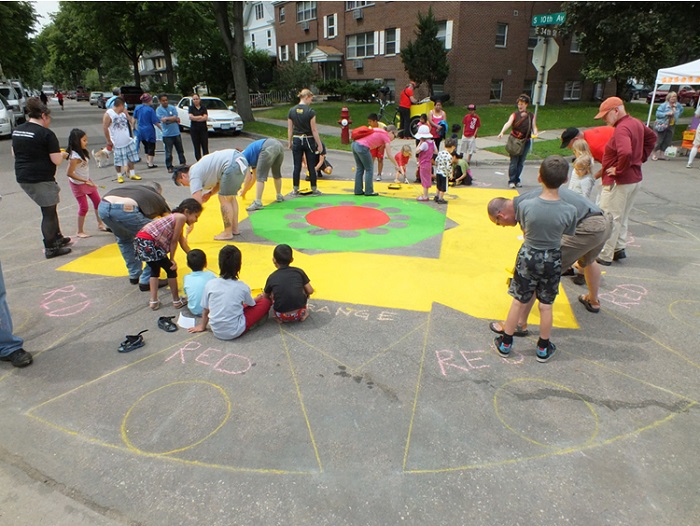- Chalk to outline design
- Paint brushes and/or paint rollers
- Water-based fast dry latex paint from a city-approved traffic marking paint line
- Shark Grip anti-skid additive
- Brooms
- Containers to hold paint
- Extra containers for mixing paint (if mixing)
- Several buckets of water for emergency clean up or to clean used brushes
- Rags for emergency clean up
- Stir sticks (if mixing)
- Name tags and markers for volunteers
- Tarp(s) to set paint on
- Wet paint signs
- Measuring tape
- Painter’s tape (if stenciling)
Order water-based fast dry latex paint from a traffic marking line of paint products well in advance of your painting date as most stores don’t keep a large stock of this type of paint. There are only a few traffic marking paint colors to choose from white, yellow, red, green, blue and black but you may mix to create other colors.
Plan to paint on a day with no wind or rain. Ensure that the pavement you’ll be painting is completely dry before you start. Don’t paint if it’s likely to rain the following day. Note that if you paint on a particularly hot day, you are likely to need more paint than if you painted on a cooler day because the paint will dry much faster, leaving you less time to spread it out with your brush.
Post flyers and signs notifying the neighborhood of your community paint date.
One week prior to the pre-determined paint date, clean your site by thoroughly sweeping the intersection twice and then hosing it down to remove any remaining particles, thereby increasing the longevity and vibrancy of your work. Allow the site to dry for a couple of days before installation as the surface of the asphalt needs to be entirely dry before painting can begin.
On the day of installation, prepare your site by setting up barricades and any required detour signage consistent with the approved MOT plan and then conducting a final sweep of the area. No street may be blocked for more than 24 hours.
Outline your design with chalk and consider labeling each section of the design by the color it will be painted. To outline circles, use string, two people, and chalk.

Add one 3.2-ounce container of Shark Grip anti-skid additive to each gallon of paint you plan to use. Mix thoroughly.
Traffic paint only comes in white, yellow, red, green, blue and black but you may mix to achieve desired colors.
To avoid walking on the paint, make sure to start painting at the center of your design, progressively working your way to the outer edges.
Be careful not to apply too much paint. Only one coat of traffic paint should be necessary to hold up well in your intersection. Thick layers of paint are likely to crack and pop off in the Florida winter. Brushes are better than rollers for applying thin coats of paint, but narrow rollers may be used to make consistent borders. One gallon should cover between 100 and 150 square feet.
Allow sufficient time for the installation to dry. It should take less than an hour to be dry to the touch but wait a few hours to walk or drive on it.
Take down the barricades and make sure to thoroughly clean your worksite, leaving no litter or waste behind. It is critical that wastewater is dumped down a sink and not down a storm drain. Storm drain water flows directly to the ocean without treatment.
Send photos of your completed design to neighborhoods@myclearwater.com so that the city can celebrate your work. If you have any suggestions for improvement to this process, please let us know.
Continue being an excellent steward of your painted intersection by retouching your design as necessary and reporting any issues that may arise to the city of Clearwater’s Traffic Operations at traffic.operations@myclearwater.com. If our maintenance crews notice that a mural is looking a little worse for the wear, we’ll email the project team to request that the mural be retouched. Murals that are not appropriately maintained during the two-year permit period must be removed.